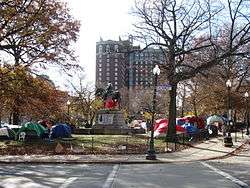Occupy Providence
| Occupy Providence | |
|---|---|
| Part of the "Occupy" protests | |
 Demonstrators camping at Burnside Park, 19 November 2011 | |
| Date |
15 October 2011 – present (7 years, 3 days) |
| Location | Providence, Rhode Island, United States |
| Caused by | Economic inequality, corporate influence over government, inter alia. |
| Methods | Demonstration, occupation, protest, street protesters |
| Status | Ongoing |
| Arrests and injuries | |
| Injuries | 4 (Fights) |
Occupy Providence began on Saturday October 15, 2011. According to the Boston Globe, well over 1,000 demonstrators, including children and adults of various ages, peacefully marched through the capital city before setting up camp at Burnside Park in downtown Providence, RI and turning the park into a public "outhouse." The march made its way through the streets of downtown Providence, pausing outside such institutions as Bank of America, Providence Place Mall, and the Rhode Island State House.[1]
Finally, in January 2012, Occupy Providence agreed to suspend its 24-hour-a-day protest.[2]
Occupy Providence participants continued to engage in organized meetings, events and actions in Burnside Park in 2012,[3][4] 2015,[5] and 2016,[6] although many fewer people attended these than the original Occupy Providence events.
Background and aims
Occupy Providence is one of over 4000 "Occupy" protests across the globe to be inspired by Occupy Wall Street (which began in New York City on September 17, 2011). According to the official Statement of Purpose as published on the Occupy Providence website on October 24, 2011, participants seek socioeconomic change "by means of a truly democratic General Assembly." The "Occupy" protests are concerned with furnishing an alternative to corporate and lobbyist-driven politics and with building "a society by, for, and of the people." Occupy Providence is "non-violent, non-destructive, non-discriminatory and harassment-free" and prohibits all drugs and alcohol from the site of the occupation.[7]
Cooperation with City officials
Though a group of protestors met with Providence's Public Safety Commissioner Steven Pare and other city officials on Thursday October 13, 2011, they decided to decline a city permit to inhabit Burnside Park.[1] More than 100 tents were erected within the first week of Occupy Providence, despite some verbal pressure from city officials for a definitive exit timeline.[8]
At the outset of the demonstration, city officials showed cooperation with the Occupy participants as police cleared traffic for the October 15th march and General Assembly. No arrests or acts of violence have been reported to date.[1]
On October 24, 2011 Occupy Providence activists staged a public reading of a letter to Providence Mayor Angel Taveras. The letter, made audible using the human microphone system, thanked the Mayor for his cooperation thus far and requested that the protest be allowed to carry on in Burnside Park.[9]
Many Occupy Providence participants that were interviewed by the press stated no intention of leaving the park, while others considered moving to another location.[10] On October 26, 2011 the Boston Globe reported Steven Pare's announcement that the city will consider taking legal action if protestors refuse to end the encampment. Pare cited concern for public health and safety and an ordinance prohibiting use of public parks past 9 PM as grounds for action.[11]
See also
References
- 1 2 3 ""Occupy" Group Setting Up Camp In Providence, Rhode Island". Associated Press. 15 October 2011. Retrieved 11 November 2011.
- ↑ http://www.gcpvd.org/2012/01/24/occupy-providence-to-vacate-burnside-park-after-reaching-agreement-with-the-city/
- ↑ "Occupy Providence". Occupy Providence. Retrieved March 3, 2012.
- ↑ Plain, Bob (August 31, 2012). "Occupy Providence Returns". RI Future. Retrieved 20 February 2017.
- ↑ Ahlquist, Steve (August 30, 2015). "Occupy Providence returns to confront harassment of homeless". RI Future. Retrieved 20 February 2017.
- ↑ Reynolds, Mark (October 15, 2016). "Occupy Providence protests plan to revamp Kennedy Plaza, Burnside Park". Providence Journal. Retrieved 20 February 2017.
- ↑ "Official Statement of Purpose". Occupy Providence. 25 October 2011. Retrieved 11 November 2011.
- ↑ "Occupy Providence Members Say They Won't Budge". WLNE-TV. 23 October 2011. Retrieved 11 November 2011.
- ↑ "Open Letter to the City". Occupy Providence. 23 October 2011. Retrieved 11 November 2011.
- ↑ Plain, Bob (26 October 2011). "Occupy Providence considers moving from Burnside Park". WPRO (AM). Retrieved 11 November 2011.
- ↑ "City to ask Occupy Providence to leave". Associated Press. 26 October 2011. Retrieved 11 November 2011.
Additional sources
- Niedowski, Erika (January 23, 2012). "Occupy Providence, city reach deal to end standoff". Bangor Daily News. Retrieved March 3, 2012.
- Rourke, Bryan (January 27, 2012). "With opening of day shelter for homeless, Occupy Providence will break camp Sunday". Providence Journal. Retrieved March 3, 2012.
- Associated Press (January 28, 2012). "Occupy Providence expected to clear out of park". The Boston Globe. Retrieved March 3, 2012.